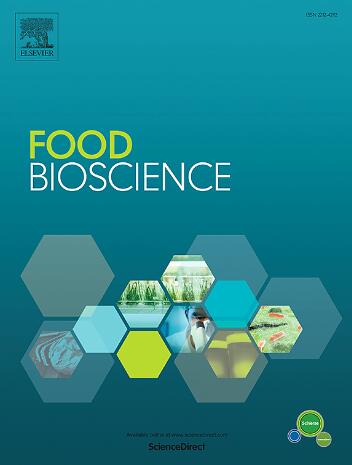Research on the physicochemical and characteristic odor indices during the oxidation process of peeled walnut kernels
IF 4.8
1区 农林科学
Q1 FOOD SCIENCE & TECHNOLOGY
引用次数: 0
Abstract
Peeled walnut kernels, rich in lipids, are prone to oxidation, resulting in undesirable odors such as rancidity and pungency due to the formation of aldehydes, ketones, and acids. This study examined kernels oxidized at 60°C over varying periods, assessing odor profiles through sensory evaluation and principal component analysis (PCA) using a gas-phase electronic nose. Threshold values for physicochemical indices such as acid value (AV), peroxide value (POV), p-anisidine value (p-AnV), total oxidation value (TOTOX), and malondialdehyde (MDA) content, were determined based on correlation analysis and oxidation kinetic models. Headspace solid phase microextraction-gas chromatography-mass spectrometry (HS-SPME/GC-MS) was utilized to analyze the volatile components of peeled walnut kernels during different oxidation times, and characteristic odor indices were determined by combining relative odor activity value (ROAV) and partial least squares regression (PLSR). The oxidation process was categorized into five stages (0–10, 15, 20, 25, and 30 days), with significant quality deterioration noted at 15 days, marked by a consumer acceptance score below 6 and dominant rancid odors. The determined threshold values were 0.9 mg/g for AV, 1.5 mmol/kg for POV, 0.9 for p-AnV, 6.0 for TOTOX, and 3.5 μg/mL for MDA, respectively. Volatile compounds such as (E,E)-2,4-decadienal, hexanal, and (E)-2-octenal were identified as key contributors to the odor profile. Among these, hexanal and (E)-2-octenal demonstrated strong predictive accuracy for POV and p-AnV, with threshold values were 1.8 and 0.9 mg/kg, respectively. This indicates that physicochemical indicators reached the threshold values at the same time as pronounced lipid oxidation and rancidity.
核桃仁去皮氧化过程中理化指标及特征气味指标的研究
去皮的核桃仁富含脂质,容易氧化,由于醛类、酮类和酸类的形成而产生酸败和辛辣等不良气味。本研究检测了60°C不同时期氧化的果仁,通过感官评估和主成分分析(PCA)评估气味特征,使用气相电子鼻。根据相关分析和氧化动力学模型,确定了酸值(AV)、过氧化值(POV)、对茴香胺值(p-AnV)、总氧化值(TOTOX)和丙二醛(MDA)含量等理化指标的阈值。采用顶空固相微萃取-气相色谱-质谱联用技术(HS-SPME/GC-MS)分析不同氧化时间下去皮核桃果核的挥发性成分,并结合相对气味活性值(ROAV)和偏最小二乘回归(PLSR)确定特征气味指标。氧化过程分为5个阶段(0-10天、15天、20天、25天和30天),在15天内发现明显的质量恶化,消费者接受分数低于6分,主要是腐臭气味。测定的阈值分别为AV 0.9 mg/g、POV 1.5 mmol/kg、p-AnV 0.9、TOTOX 6.0、MDA 3.5 μg/mL。挥发性化合物,如(E,E)-2,4-十烯醛,己醛和(E)-2-辛醛被确定为气味特征的关键贡献者。其中,己醛和(E)-2-辛醛对POV和p-AnV具有很强的预测准确性,阈值分别为1.8和0.9 mg/kg。这表明,在脂质氧化和酸败明显的同时,理化指标达到了阈值。
本文章由计算机程序翻译,如有差异,请以英文原文为准。
求助全文
约1分钟内获得全文
求助全文
来源期刊

Food Bioscience
Biochemistry, Genetics and Molecular Biology-Biochemistry
CiteScore
6.40
自引率
5.80%
发文量
671
审稿时长
27 days
期刊介绍:
Food Bioscience is a peer-reviewed journal that aims to provide a forum for recent developments in the field of bio-related food research. The journal focuses on both fundamental and applied research worldwide, with special attention to ethnic and cultural aspects of food bioresearch.
 求助内容:
求助内容: 应助结果提醒方式:
应助结果提醒方式:


